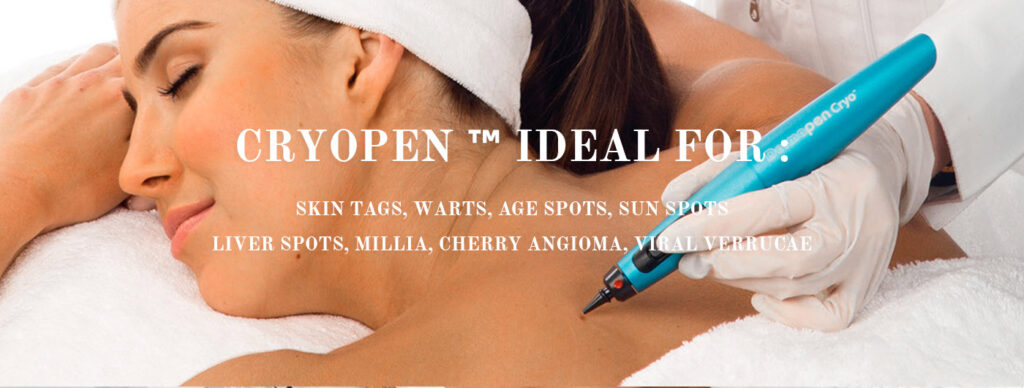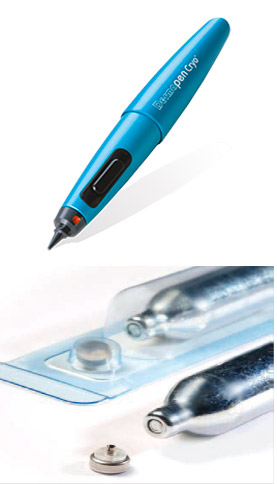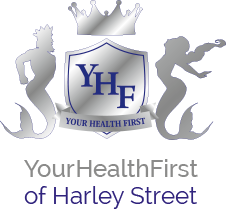

Cryo Advancing Cryotherapy for Skin Lesion Removal
Cryo™ is an advanced cryotherapy innovation utilizing disposable cartridges of liquefied N2O to deliver an extremely fast, effective treatment that eliminates benign skin lesions. The nitrous oxide breaks down tissues by freezing the intercellular fluid, forming ice shards and crystals that rupture the cell’s membrane, completely destroying the cells.
Because it delivers N2O directly onto the lesion and not the healthy surrounding tissue, it safely treats lesions on the face and around the delicate eye area. Cryo™ is unparalleled in its effectiveness and speed; it delivers a highly targeted, ultra-cold, high pressure N2O jet directly onto the lesion with a penetration rate of 1mm per 5 seconds. It has the ability able to reach a depth of 5mm.
Cryo™ Advantages And Key Features
- Ultra cold N2O (-89 degrees)
- High pressure delivery (725psi)
- Pinpoint accuracy; treats lesions from 1mm to 10mm in size
- Safely treats lesions on face and the delicate eye area
- Flexible treatment options
- Effective – treats the lesion and not the healthy surrounding tissue.
- No follow-up care needed
- Does not contact the skin
Areas Can Be Treated With Cryotherapy
- Skin tags
- Warts
- Age spots
- Sun spots
- Liver spots
- Millia
- Cherry angioma
- Viral verrucae
Frequently Asked Questions About Cryotherapy (FAQ’s)
Cryopen® Therapy is relatively low risk. There are a few side effects that may occur as a result of treatment, including: • Pigmentary changes (hypopigmentation and hyperpigmentation) •
Nerve damage (particularly in areas where nerves lie close to the surface of the skin, on fingers, wrist, area behind the ear) • Shards of frozen ice (minor shards of frozen ice may blow out, that will thaw on contact with healthy skin) •
Hair follicle damage and permanent alopecia (especially when treating lesions on sites with coarse terminal hair) Discuss any concerns with your clinician.
The penetration rate of freezing with the Cryopen® is approximately 1mm per 5 seconds, with a maximum freezing depth of 3 to 6mm depending on the used applicator.
The duration of the treatment time will depend on the surface area and the thickness of the tissue being treated. Upon the clinical evaluation of the thickness of the lesion, the operator will choose an application time from 1 to 30 seconds.
Most small common warts will respond to a single treatment. However, certain types and very deep ones can be very difficult to remove and may require more than one treatment. for more details read more
For most lesions, cryotherapy is a permanent removal. Some lesions are harder to remove than others.
In addition, it is necessary to obtain a result with the least damage to the surrounding skin. In other instances, a deep lesion may take several aggressive treatments to get results. It is important to have an instrument that can adapt to variable dosing of power.
Yes, but cautions about skin type and location be considered prior to deciding on freeze times. People with high levels of cryoglobulins should be treated with caution.
If with dark skin, one may not want to have cryotherapy, it will kill the melanocytes around the treated area, making the skin in that area lighter.
The applicator is held as close as possible to the skin imperfection and moved quickly towards and away from it. This could be from 1-30 seconds,
depending on the size and depth. After the first freeze cycle, the tissue can thaw for about 30 seconds. Now the second freeze cycle will begin. The tissue will freeze faster than during the first freezing cycle.
Only wash with cold or tepid water for the first day, be gentle on your skin and avoid the use of strong lotions or soaps,exfoliating creams and aggressive scrubbing to the treated area. As this may causes you light discomfort.
Do not apply make up the same day unless It is a mineral make-up.
“ Cryo™ has been a great success with both my therapists and client base a like. My business has grown and word of mouth is bringing additional clients daily. Our aim is offering Anti-ageing treatments and the Cryo™ is now a vital part of our treatments for pigmentation.”
JACKIE RENFREY, THE ABBEY, NOTTINGHAM
Our prices
Opening hours
Monday to Friday -10am to 7pm
Saturday -12am to 4pm
Sunday -Only by appointment
Out of hours -Only by appointment
Get an appointment
By phone:
T: 0207 225 3582
M: 078 1847 4041
By email: info@yourhealthfirst.uk










